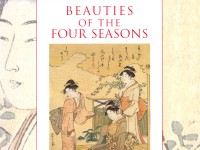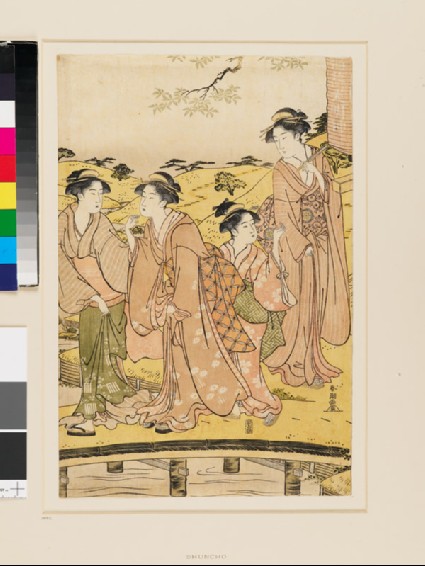Beauties of the Four Seasons
A full catalogue of the Ashmolean’s collection of Japanese bijinga (beautiful women) prints by Mitsuko Watanabe (published Oxford, 2005).

Publications online: 54 objects
Visitors to the Inari Daimyōjin Shrine
-
Literature notes
Katsukawa Shunchō was a pupil of Katsukawa Shunshō (1726-92) but his dates are unknown. Shunchō produced mainly bijinga, under the strong influence of the Kiyonaga style of beauties, as opposed to that of his master, Shunshō, who specialized in depicting kabuki actors. Later in his life, Shunchō gave up being as an ukiyo-e artist and became a poet.
This print is the centre sheet of a triptych. It illustrates two ladies with a young girl and their maid crossing a low bridge going towards the Inari Daimyōjin Shrine on a sunny day. The lantern to the right has the inscription 'Inari Daimyōjin'. There were four Inari Shrines in Yoshiwara where festivals took place. The hilly landscape in the background shows the vast grounds of the shrine. With the ladies wearing hitoe (one layer of kimono) and one of them holding a fan, it is probably early autumn. -
Details
- Associated place
- Date
- 1780 - 1795
- Artist/maker
-
Katsukawa Shunchō (active 1780 - 1795) (designer)
- Associated people
-
Izumiya Ichibei (active 1770s - 1886) (publisher)Kansendō (active 1770s - 1886) (publisher)
- Material and technique
- nishiki-e (multi-block) woodblock print, printed with water-based vegetable pigments
- Dimensions
-
mount 55.3 x 40.6 cm (height x width)
print 36.6 x 24.4 cm (height x width)
- Material index
- Technique index
- Object type index
- No. of items
- 1
- Credit line
- Presented by Mrs Allan and Mr and Mrs H. N. Spalding, 1952.
- Accession no.
- EAX.4715
-
Further reading
Oxford: Ashmolean Museum, 24 August-30 November 2005, Beauties of the Four Seasons, Mitsuko Watanabe, ed. (Oxford: Ashmolean Museum, 2005), no. 8 on p. 16, illus. p. 17
Glossary (2)
nishiki-e, vegetable pigments
-
nishiki-e
Nishiki-e literally means 'brocade pictures' and refers to multi-coloured woodblock prints.
-
vegetable pigments
Vegetable pigments were used to create coloured dyes for Japanese prints, paintings, and textiles. These pigments often faded over time due to the chemical reactions they underwent.
Location
-
- currently in research collection
Objects are sometimes moved to a different location. Our object location data is usually updated on a monthly basis. Contact the Jameel Study Centre if you are planning to visit the museum to see a particular object on display, or would like to arrange an appointment to see an object in our reserve collections.
Publications online
-

Beauties of the Four Seasons
Katsukawa Shunchō was a pupil of Katsukawa Shunshō (1726-92) but his dates are unknown. Shunchō produced mainly bijinga, under the strong influence of the Kiyonaga style of beauties, as opposed to that of his master, Shunshō, who specialized in depicting kabuki actors. Later in his life, Shunchō gave up being as an ukiyo-e artist and became a poet.
This print is the centre sheet of a triptych. It illustrates two ladies with a young girl and their maid crossing a low bridge going towards the Inari Daimyōjin Shrine on a sunny day. The lantern to the right has the inscription 'Inari Daimyōjin'. There were four Inari Shrines in Yoshiwara where festivals took place. The hilly landscape in the background shows the vast grounds of the shrine. With the ladies wearing hitoe (one layer of kimono) and one of them holding a fan, it is probably early autumn.
Notice
Object information may not accurately reflect the actual contents of the original publication, since our online objects contain current information held in our collections database. Click on 'buy this publication' to purchase printed versions of our online publications, where available, or contact the Jameel Study Centre to arrange access to books on our collections that are now out of print.
© 2013 University of Oxford - Ashmolean Museum

